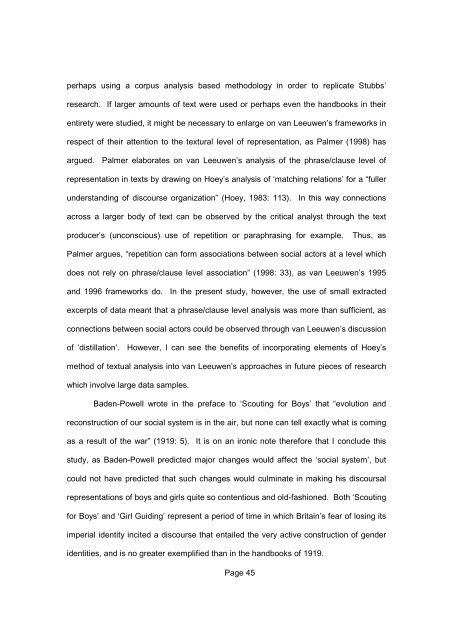A Discussion of the Representation of Masculinity and Femininity in ...
A Discussion of the Representation of Masculinity and Femininity in ...
A Discussion of the Representation of Masculinity and Femininity in ...
Create successful ePaper yourself
Turn your PDF publications into a flip-book with our unique Google optimized e-Paper software.
perhaps us<strong>in</strong>g a corpus analysis based methodology <strong>in</strong> order to replicate Stubbs’<br />
research. If larger amounts <strong>of</strong> text were used or perhaps even <strong>the</strong> h<strong>and</strong>books <strong>in</strong> <strong>the</strong>ir<br />
entirety were studied, it might be necessary to enlarge on van Leeuwen’s frameworks <strong>in</strong><br />
respect <strong>of</strong> <strong>the</strong>ir attention to <strong>the</strong> textural level <strong>of</strong> representation, as Palmer (1998) has<br />
argued. Palmer elaborates on van Leeuwen’s analysis <strong>of</strong> <strong>the</strong> phrase/clause level <strong>of</strong><br />
representation <strong>in</strong> texts by draw<strong>in</strong>g on Hoey’s analysis <strong>of</strong> ‘match<strong>in</strong>g relations’ for a “fuller<br />
underst<strong>and</strong><strong>in</strong>g <strong>of</strong> discourse organization” (Hoey, 1983: 113). In this way connections<br />
across a larger body <strong>of</strong> text can be observed by <strong>the</strong> critical analyst through <strong>the</strong> text<br />
producer’s (unconscious) use <strong>of</strong> repetition or paraphras<strong>in</strong>g for example. Thus, as<br />
Palmer argues, “repetition can form associations between social actors at a level which<br />
does not rely on phrase/clause level association” (1998: 33), as van Leeuwen’s 1995<br />
<strong>and</strong> 1996 frameworks do. In <strong>the</strong> present study, however, <strong>the</strong> use <strong>of</strong> small extracted<br />
excerpts <strong>of</strong> data meant that a phrase/clause level analysis was more than sufficient, as<br />
connections between social actors could be observed through van Leeuwen’s discussion<br />
<strong>of</strong> ‘distillation’. However, I can see <strong>the</strong> benefits <strong>of</strong> <strong>in</strong>corporat<strong>in</strong>g elements <strong>of</strong> Hoey’s<br />
method <strong>of</strong> textual analysis <strong>in</strong>to van Leeuwen’s approaches <strong>in</strong> future pieces <strong>of</strong> research<br />
which <strong>in</strong>volve large data samples.<br />
Baden-Powell wrote <strong>in</strong> <strong>the</strong> preface to ‘Scout<strong>in</strong>g for Boys’ that “evolution <strong>and</strong><br />
reconstruction <strong>of</strong> our social system is <strong>in</strong> <strong>the</strong> air, but none can tell exactly what is com<strong>in</strong>g<br />
as a result <strong>of</strong> <strong>the</strong> war” (1919: 5). It is on an ironic note <strong>the</strong>refore that I conclude this<br />
study, as Baden-Powell predicted major changes would affect <strong>the</strong> ‘social system’, but<br />
could not have predicted that such changes would culm<strong>in</strong>ate <strong>in</strong> mak<strong>in</strong>g his discoursal<br />
representations <strong>of</strong> boys <strong>and</strong> girls quite so contentious <strong>and</strong> old-fashioned. Both ‘Scout<strong>in</strong>g<br />
for Boys’ <strong>and</strong> ‘Girl Guid<strong>in</strong>g’ represent a period <strong>of</strong> time <strong>in</strong> which Brita<strong>in</strong>’s fear <strong>of</strong> los<strong>in</strong>g its<br />
imperial identity <strong>in</strong>cited a discourse that entailed <strong>the</strong> very active construction <strong>of</strong> gender<br />
identities, <strong>and</strong> is no greater exemplified than <strong>in</strong> <strong>the</strong> h<strong>and</strong>books <strong>of</strong> 1919.<br />
Page 45

















